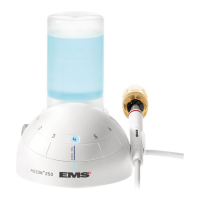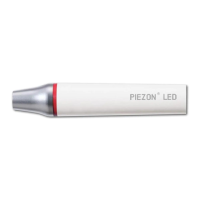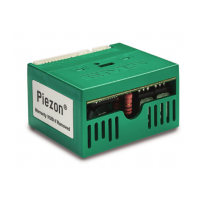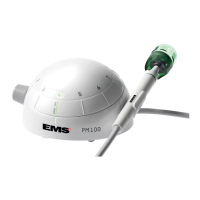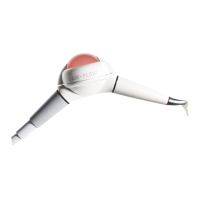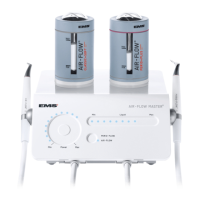31
SCALING
Specialspets PI för rengöring
av implantat
Borttagning av plack och tandsten från implantat
och från rekonstruktioner av metall eller keramik.
Ytrengöring på proteser. Måste användas med en
120° lhållare.
Använd låg effekt eller medelhög effekt för hård
tandsten.
Använd ett högt till medelhögt spolningsöde.
Kontrollera att plastbeläggningen inte är
sliten eller skadad före användning. Vi rekom-
menderar att en gummiduk används för att hindra
patienten från att svälja eller inandas slipdamm. Om
det inte går att använda gummiduk bör patienten
instrueras att andas genom näsan.
Strumento specico PI per la pulizia
di impianti
Rimozione di placca e calcoli dalla supercie di
impianti e da restauri metallici e ceramici. Pulizia
di superci su unità protesiche. Da utilizzare con
un portalime da 120°.
Per concrezioni dure regolare la potenza su valori
bassi o intermedi.
Usare una velocità del usso di irrigazione da alta
a intermedia.
Controllare che il rivestimento in plastica
non sia usurato o danneggiato prima dell'uso. Si
consiglia di usare una diga di gomma per prevenire
la deglutizione o inalazione accidentali di detriti.
Quando non è possibile usare una diga di gomma,
chiedere al paziente di respirare dal naso.
Instrumento PI especíco para
la limpieza de implantes
Eliminación de placa y sarro de la superficie
de implantes y de restauraciones metálicas o
cerámicas. Limpieza de la supercie de unidades
protésicas. Debe utilizase con un portalimas de
120°.
Use un ajuste de potencia bajo o uno medio para
cálculos duros.
Use un ujo de irrigación de alto a medio.
Compruebe que el recubrimiento de
plástico no esté gastado o dañado antes de
usar. Se recomienda usar un dique de goma para
impedir que el paciente trague o inhale residuos
accidentalmente. Cuando no pueda utilizarse un
dique de goma, indique al paciente que respire
por la nariz.
Spezialinstrument PI für
die Implantatreinigung
Zum Entfernen von Plaque und Zahnstein von Implantat-
oberächen und Restaurationen aus Metall oder Keramik.
Zum Reinigen von Prothesenoberächen. Muss mit einem
120°-Feilenhalter verwendet werden.
Arbeiten Sie mit niedriger Leistungseinstellung oder
mittlerer Leistungseinstellung bei harten Konkrementen.
Stellen Sie eine hohe bis mittlere Durchussrate ein.
Stellen Sie sicher, dass die Kunststoffbeschichtung
des Instruments nicht abgenutzt oder beschädigt ist.
Wir empfehlen das Anlegen eines Kofferdamms, um
das Verschlucken oder Einatmen eines gelösten oder
abgebrochenen Fragments zu verhindern. Sollte es nicht
möglich sein, einen Kofferdamm anzulegen, sollte der
Patient angewiesen werden, während der Behandlung
durch die Nase zu atmen.
Instrument spécique PI pour
le nettoyage d’implants
Elimination de la plaque et du tartre sur la surface
d’implants et sur des restaurations métal ou
céramique. Nettoyage de surface des unités
prothétiques. Utiliser avec un porte-lime à 120°.
Utiliser un réglage de puissance bas ou moyen en
cas de tartre dur.
Utiliser un débit d’irrigation élevé à moyen.
Vérier avant utilisation que le surmoulage
plastique n’est ni usé ni endommagé. Il est
recommandé de poser une digue pour éviter une
ingestion ou inhalation accidentelle de débris par
le patient. Pour les traitements où l’utilisation d’une
digue est impossible, informer le patient qu’il doit
respirer par le nez.
Specic instrument PI for implants
cleaning
Removal of plaque and calculus from the surface
of implants and from metal or ceramic restorations.
Surface cleaning on prosthesis units. Must be used
with a 120° le holder.
Use a low power setting or medium power for hard
concrements.
Use a high to medium irrigation ow rate.
Verify that the plastic coating is not worn
or damaged before use. We recommend to use a
rubber dam to prevent the patient from accidentally
swallowing or inhaling debris. When a rubber dam
cannot be used, instruct the patient to breathe
through the nose.
FB-439_3_Piezon instruments.indd 31 28.10.2015 14:49:24

